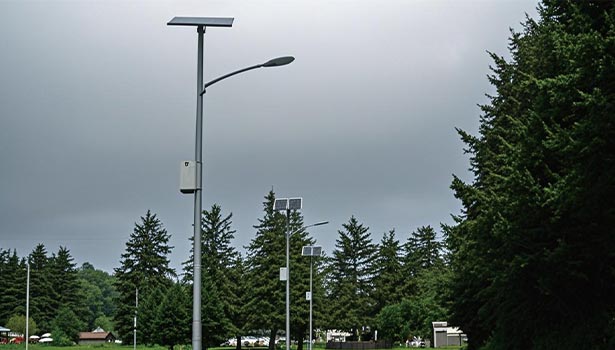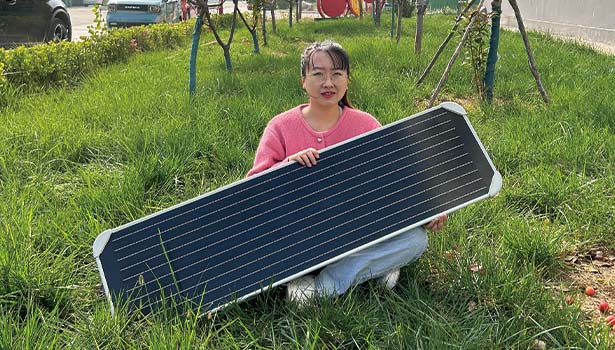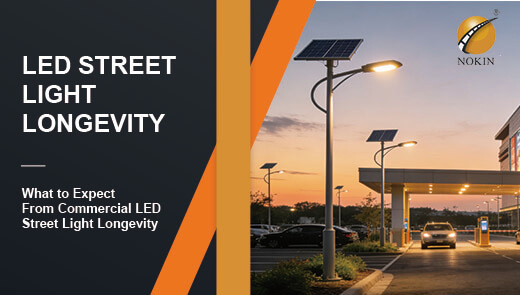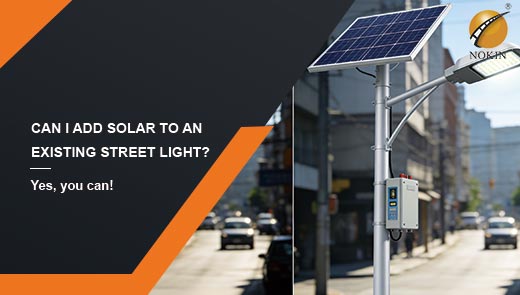Top Features To Look For In High Performance Solar Street Lights
In the context of the global push for green energy and smart city construction, solar street lights have become the mainstream choice for outdoor lighting due to their energy-saving and environmentally friendly advantages, and the fact that they do not require grid power. However, not all solar street lights can meet the demand for long-term and efficient use. If you want to select a truly high-performance product, you need to focus on the following core features, which together determine the street light's energy conversion efficiency, endurance, durability and level of intelligence.

High-Efficiency Solar Panels
Solar panels are the core energy source of solar street lights, and their conversion efficiency directly determines how much solar energy they can absorb during the day, which in turn affects the length and stability of lighting at night. When choosing, you need to prioritize the type and efficiency parameters of solar panels. At present, the mainstream solar panels on the market are mainly divided into monocrystalline silicon, polycrystalline silicon and amorphous silicon three categories, there are significant differences in the performance of the three, the specific comparison is as follows:
|
Solar Panel Type |
Conversion Efficiency |
Low-Light Performance |
Lifespan |
|
Monocrystalline Panel |
18%–24% |
Excellent, maintains high efficiency even on cloudy days |
25–30 years |
|
Polycrystalline Panel |
15%–18% |
Good, slightly lower efficiency than monocrystalline in weak light |
20–25 years |
|
Amorphous Silicon Panel |
6%–10% |
Poor, efficiency drops significantly in low-light conditions |
10–15 years |
High-performance solar street lights generally use monocrystalline silicon solar panels, which have a more regular crystal structure and higher electron migration efficiency, which can not only maximize energy absorption under sufficient light, but also maintain stable power generation in low-light environments such as dawn, dusk or cloudy days, ensuring that the street lights, even when the light conditions are not good, can also achieve "fully charged during the day, and continue to be bright at night ".
Long-Life Lithium-Ion Batteries
If solar panels are “energy collectors”, batteries are “energy storage stations”. High-performance solar street lights must be equipped with high-capacity, long-life batteries in order to store enough energy to support nighttime lighting and even cope with continuous rainy weather. Traditional solar street lights mostly use lead-acid batteries, but with the development of technology, lithium batteries have become the standard for high-performance products, and a comparison of the core performance of the two is shown in the table below:
|
Performance Indicator |
Lithium Battery (Mainstream Choice for High-Performance Street Lights) |
Traditional Lead-Acid Battery |
|
Energy Density |
High (approx. 150–200 Wh/kg), compact and lightweight |
Low (approx. 30–50 Wh/kg), bulky and heavy |
|
Charge/Discharge Cycles |
2000–3000 cycles (capacity remains above 80% after cycles) |
300–500 cycles (capacity drops significantly after cycles) |
|
Charging Speed |
Fast, fully charged in 4–6 hours |
Slow, requires 8–12 hours to fully charge |
|
Low-Temperature Performance |
Excellent, operates normally at -20℃ |
Poor, capacity drops sharply below -10℃, prone to freezing damage |
|
Maintenance Requirement |
Almost maintenance-free, sealed design prevents leakage |
Requires regular water refilling and electrolyte checks, high maintenance cost |
High-performance solar street lamps equipped with lithium batteries usually have a large capacity of more than 100Ah, combined with intelligent charge/discharge management technology, can realize “a charge, 3-5 consecutive cloudy and rainy days normal lighting”, while its long cycle life can be matched with the service life of the solar panel, avoiding frequent replacement of batteries in the short term and reducing the late maintenance costs.
Smart Control Systems
With the development of IoT technology, “intelligence” has become the core competitiveness of high-performance solar street lights. A set of advanced intelligent control system can not only greatly improve the efficiency of energy utilization, but also realize remote monitoring and active maintenance to reduce operating costs.
Dynamic Brightness Adjustment
Intelligent control system can realize brightness adjustment through time-controlled adjustment and human body sensing adjustment, of which time-controlled adjustment is to automatically adjust the lighting brightness according to the local sunrise and sunset time, for example, the brightness can be reduced to 50% in the evening and early morning when the flow of people is low, and 100% brightness can be restored in the nighttime peak period.
Human body sensing adjustment is when the sensor detects pedestrians and vehicles passing by, the brightness is instantly raised to 100%, and automatically lowered to 30%-40% when there is no one and no vehicle, this mode of supplying light on demand not only ensures safety, but also effectively reduces the energy consumption, the data show that the solar street light equipped with sensing adjustment can save 40%-60% of the power compared with the constant brightness mode, and the battery life is extended by 2-3 times.

Remote Monitoring and Management
Some of the high-end solar street lights support cloud platform / APP remote control, through the system, managers can check the operation status of each street light in real time, including battery power, light intensity and whether there is a failure, etc., and also can remotely issue control instructions, such as adjusting brightness, restarting the device, etc. Once there is a failure of the street light, such as a battery failure, it can be controlled by a remote control system. Once a street light fails, such as battery loss, solar panel blockage, etc., the system will automatically send an alarm message, allowing managers to pinpoint the location of the failure, eliminating the need for extensive manual inspections and increasing maintenance efficiency by more than 80%.
Weather Resistance and Durability
Protection Class (IP Class)
IP Class consists of two digits, and the protection class of high-performance solar street light should reach IP65 and above, where the first digit “6” means that it completely prevents the intrusion of dust, and there is no accumulation of dust in the interior, and the second digit “5” means that it completely prevents the intrusion of dust. The second digit “5” means to prevent the intrusion of jet water, such as rainstorms, high-pressure water gun flushing, etc. No water inside the equipment.
If it is installed in the coastal areas where typhoons and rainstorms are frequent, or in the northern areas where sand and dust are serious, it is recommended to choose IP67 level products, which can be fully immersed in 1 meter deep water for 30 minutes without damage, and can better adapt to extreme environments.
Shell Material and Structure
High performance solar street light pole, lamp head shell is mostly made of corrosion-resistant aluminum alloy or stainless steel, aluminum alloy material is lightweight, high strength, and the corrosion resistance can be improved 5-10 times after Surface anodizing treatment, which can effectively resist the erosion of acid rain and sea breeze, while stainless steel material, especially the 304 or 316 material is more weather-resistant, which is suitable for high humidity, high salinity in coastal or chemical industry areas.
The stainless steel material, especially 304 or 316, is more weather resistant and suitable for coastal or chemical areas with high humidity and salt. In addition, the bottom of the pole should be equipped with a lightning protection grounding device to avoid damage to the internal circuits during thunderstorms and to ensure the safe operation of the street lights under extreme weather conditions.
Adjustable Lighting Angle and Design Flexibility
Solar Panel Adjustable Angle
The tilt angle of the solar panel directly affects the efficiency of its absorption of sunlight, and the optimal angle is usually the same as the local latitude, and the solar panels of the high-performance solar street lights are mostly designed with manual/electrically adjustable design, and the tilt angle can be adjusted according to the latitude and the direction of light at the site, which ensures that the street lights can be operated all year round. The solar panels of high-performance solar street lights mostly adopt manual/electrically adjustable design, which can be adjusted according to the latitude and light direction of the site when installing, to ensure that the solar energy can be absorbed in the best position throughout the year.
Rotatable Lamp Head with Adjustable Luminance
The lamp head supports horizontal rotation (0°-360°) and vertical tilt (-15°-45°), which can be adjusted according to different installation scenarios. For example, in the main road of the city, when the lamp head tilt angle is adjusted to 10°-15°, the light will cover the road surface width of up to 12-15 meters, which ensures that there is no dead angle of the illumination of the bi-directional lanes.

Bright LED Lights with Adjustable Luminance
High Brightness and Low Energy Consumption
The luminous efficacy of high-performance LED beads needs to reach more than 130lm/W, which is much higher than that of traditional high-pressure sodium lamps (40-60lm/W), for example, the brightness of a 100W LED street light is equivalent to that of a 250W high-pressure sodium lamp, but the energy consumption is only 40% of the latter. However, the energy consumption is only 40% of the latter, which greatly reduces the burden on the battery.
Meanwhile, the color temperature of LED beads can be adjusted between 3000K-6500K. 3000K warm white light is suitable for residential areas (residential areas), with a soft light to create a warm atmosphere, while 5000K positive white light is suitable for main roads and highways in cities, with a clear light that can enhance visual recognition at night, meeting the lighting needs of different scenes.
Long Service Life & Warranty
The “cost-effectiveness” of high performance solar street light is not only reflected in the initial performance, but also in the long-term cost of use, you need to pay attention to the “expected service life” and “manufacturer's warranty” of the product when choosing. When choosing a product, you need to pay attention to the “expected service life” and “manufacturer's warranty”, which is a direct reflection of product quality.
Service Life of Core Components
|
Core Component |
Expected Lifespan |
Key Assurance Measures |
|
Solar Panel |
25–30 years |
High-purity monocrystalline silicon, anti-glare tempered glass cover |
|
Lithium Battery |
8–12 years |
Equipped with BMS (Battery Management System) to prevent overcharge, overdischarge, and short circuits |
|
LED Chips |
50,000–80,000 hours (approx. 5–8 years) |
Imported chips, silicone encapsulation, optimized heat dissipation structure |
|
Housing & Pole |
15–20 years |
Aluminum alloy anodizing, stainless steel anti-corrosion treatment |
Warranty Period and Scope
Formal manufacturers of high-performance solar street light warranty period is usually 5-10 years, and the warranty covers the core components (solar panels, batteries, LED beads, control systems), some manufacturers also provide “lifelong maintenance services”, such as free replacement of faulty parts, regular door-to-door inspection, etc., which significantly reduces the late Operational risk.
However, it should be noted that some low-priced products claim “5-year warranty”, but only covers non-core components such as light poles, batteries, solar panels and other vulnerable parts are only guaranteed for 1-2 years, so you need to carefully check the warranty terms when choosing, to avoid the problem of high maintenance costs in the future.
Easy Installation and Maintenance
Installation Convenience
High-performance solar street light adopts no wiring design, no need to excavate the road surface to lay cables, only need to fix the light pole, adjust the angle of the solar panel to complete the installation, the installation time is more than 60% shorter than the traditional grid street light, the installation time of a single lamp is about 1-2 hours, significantly reducing the construction cycle and labor costs. The installation time for a single lamp is about 1-2 hours, which greatly reduces the construction period and labor cost.
Meanwhile, it adopts modular design, solar panels, batteries, lamp head and control system are modular assembly, which can be disassembled and replaced individually without dismantling the whole system, making it more convenient to replace the parts in the later stage; in addition, the lamp pole is made of thin-walled aluminum alloy, which weighs 40% lighter than the traditional steel pole, and the installation can be completed by manual labor without the need of large-scale lifting equipment, which further reduces the difficulty and cost of the installation.
Simplicity of Maintenance
In terms of maintenance, the battery box of the high performance solar street light adopts side-opening design, so that the battery can be replaced without dismantling the pole, and the LED light head adopts snap type installation, which can be removed by unscrewing the screws, thus reducing the maintenance operation steps.
In addition, the lithium battery is almost maintenance-free, the sealing design can prevent liquid leakage, the surface of the solar panel adopts anti-fouling coating, and the rainwater can automatically wash away the dust, so it only requires 1-2 times of cleaning and maintenance per year, which reduces the maintenance cost by 70% compared with the traditional street lamps, and makes the long-term operation more economical.
Selecting a high-performance solar street light requires comprehensive consideration of core component performance, intelligence level, environmental adaptability, whole life cycle cost and ease of installation and maintenance. Only by meeting these key features at the same time, solar street lights can truly meet the development needs of green energy and smart cities, providing stable and safe outdoor lighting while maximizing the advantages of energy saving and environmental protection, and providing reliable support for urban infrastructure construction and sustainable development.




